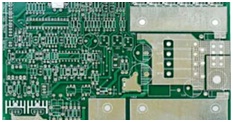 PCBs (printed circuit boards) have, more or less, become a very vital part of modern electronic equipment. In fact, if you were to disintegrate any electronic equipment in your house, the chances are that you are going to come face to face with one of myriad types of PCBs. A basic printed circuit board is comprised of a very large number of passive and active components. They are connected from side to side with traces on the board. It is wholly possible to develop very large circuits on small printed circuits boards with the availability of very small sized electronic components.
PCBs (printed circuit boards) have, more or less, become a very vital part of modern electronic equipment. In fact, if you were to disintegrate any electronic equipment in your house, the chances are that you are going to come face to face with one of myriad types of PCBs. A basic printed circuit board is comprised of a very large number of passive and active components. They are connected from side to side with traces on the board. It is wholly possible to develop very large circuits on small printed circuits boards with the availability of very small sized electronic components.
But that is not all PCBs are good for. Printed circuit board offer varied advantages which make them the perfect choice for the manufacturers of electronic components, instruments and equipment everywhere.
Keep on reading to find out what they are.
Compact Size
A characteristic PCB includes a large number of electronic components. Most of these components are very small in size. It would be close to impossible to connect these components together with wires without the aid of printed circuit boards. A typical printed circuit board offers a simple platform to align the electronic components in a compressed and efficient way. This compactness allows creation of big and complicated electronic circuits in small form factors. This, in turn, takes less space in devices.
Ease in Repair and Diagnostic
One great thing about printed circuit boards is that they are helpful in performing diagnostics for a number of reasons. The electronic components and their polarities on a properly designed printed circuit boards are evidently labeled on the board. This allows convenience during the installation process as well as repair process. Signal paths are often traced during diagnostics. Doing this would be wholly difficult to perform if the traces were not clear to the view and well organized.
Immune to Movement
Another worthwhile thing to notice is that all the components on a PCB are held fixed to the board. This is done by solder flux which does not allow them to move irrespective of the movement of the board itself. Because of this, the electronic circuit (that move or shake) can be placed in devices without worrying about the possibility of displacement of the electronic components and any subsequent electronic short circuits.
Low Electronic Noise
A printed circuit board (that has been properly laid out) lessens electronics noise. If it is not laid out properly then the noise could significantly degrade performance. The electrical components on a printed circuit board are organized in a way that the path lengths of the electrical current between them are lessens. This leads to low radiation and pickup of electromagnetic waves, thus ensuring lower cross talk in between components and in between varied traces, which usually is a major concern in electronic circuits.
These are just some of the advantages PCBs offers. To avail more advantages from professionally manufactured PCBs, you can contact us anytime. You can also contact us for custom printed circuit board and prototype printed circuit board fabrication.
